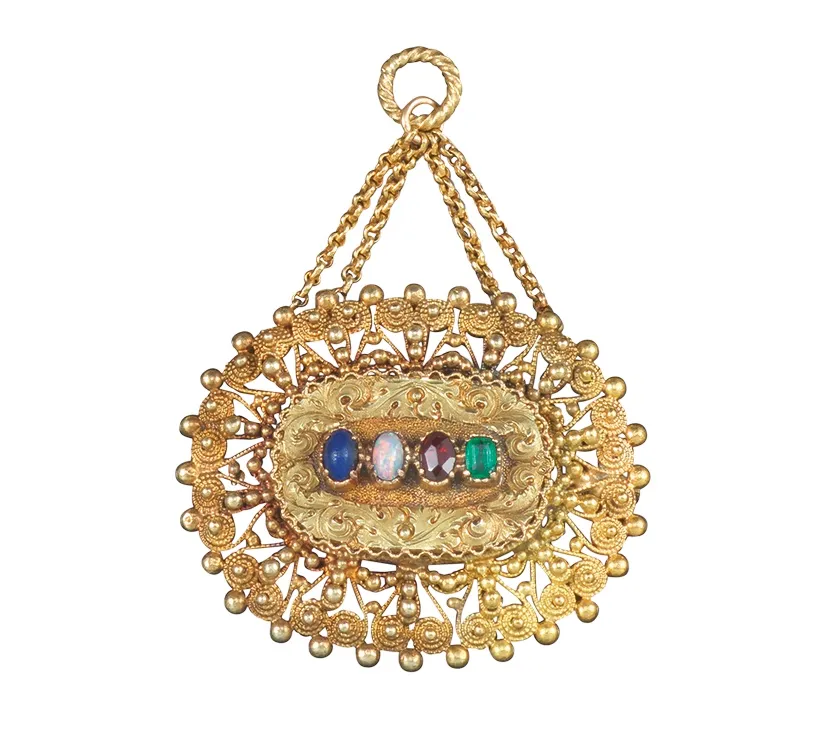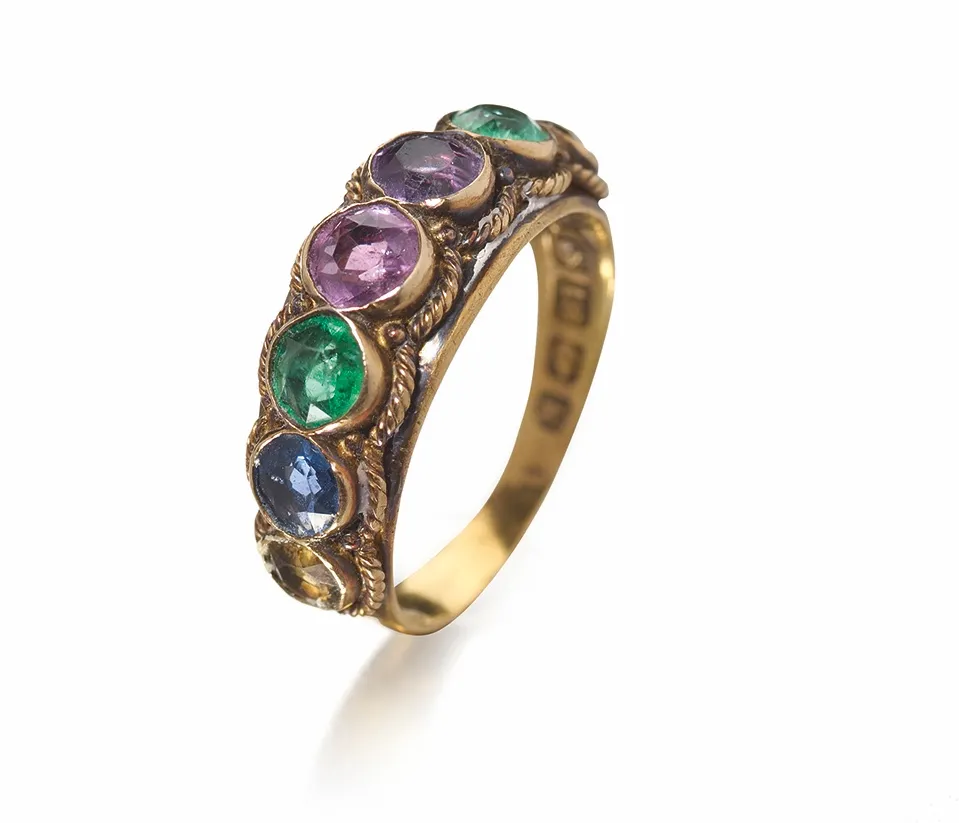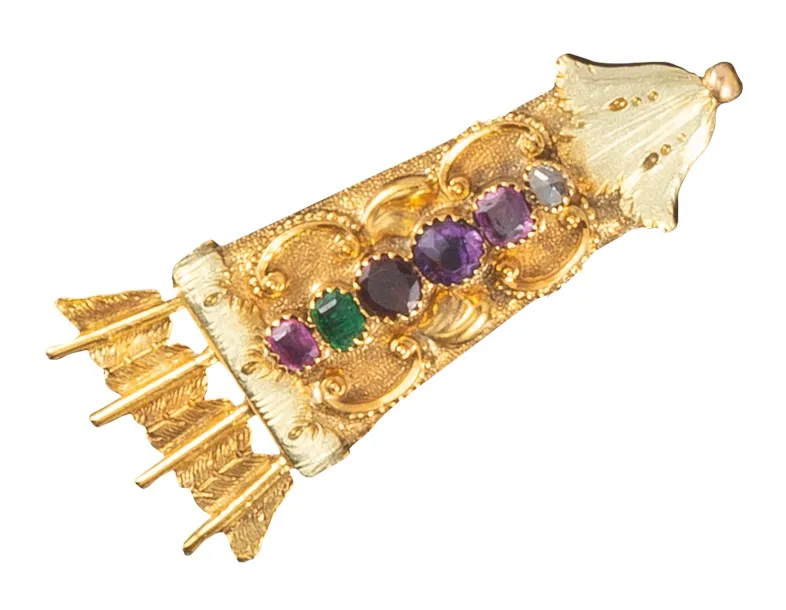Forget the anonymous valentine – how much more romantic is a message in a ring or a necklace, conveyed in the arrangement of gems it contains? Antique acrostic jewellery is so called because the first letter of each gem it features spells out a secret word. So, for example, a ring featuring an amethyst, a diamond, an opal, a ruby and an emerald signifies the word Adore.
‘People love this type of jewellery because it taps into their sentimental streak, and it relates to them personally,’ says jewellery expert John Benjamin. ‘Plus, it’s often made at a time when goldsmithing was very fine, and there are motifs like hearts, and keys and locks, and multi-coloured gold. So you might have a Georgian locket in the form of a padlock with two or three colours of gold, and then a line of stones spelling Regard. It’s all very pretty and links into the idea of gems being eternal reminders of the love you feel for somebody.’
Who created the first acrostic jewellery design?
Cleverly contrived jewels of this kind have provided lovers with a secret way to signal their devotion to one another since the early 19th century. ‘Royal French jeweller Jean-Baptiste Mellerio was the first commercial exploiter of the idea in 1809. Napoleon thought the idea was enchanting and commissioned several important pieces for family members,’ explains John. ‘The most notable pieces of acrostic jewellery were a set of three bracelets belonging to Napoleon’s second wife, Empress Marie Louise, representing the couple’s names, dates of birth and marriage. It’s said the jewels were arranged by the Empress to amuse herself when Napoleon was away on campaign.’

How can you spell out words using gemstones?
In French-made jewels, Souvenir, Amitié, J’Adore and Amour are the most popular words of endearment spelled out in gemstones. When the fashion crossed the Channel, words such as Regard, Dearest, Dear, Esteem, Forever and Love feature. The design of a setting may also underline its romantic message – flowers (especially pansies, roses and forget-me-nots), locks, hands, knots and hearts are all popular forms for acrostic jewels.
Deciphering the secret word isn’t always easy because gems were called by different names at different times and vary according to where the piece was made. ‘For instance, vermeil often stands for V in love, but the gem is known as garnet today,’ says John. Jewels may also spell out a name rather than a word. In 1862, Edward VII proposed to Alexandra of Denmark with a gold acrostic ring made by Garrard & Co, and set with beryl, emerald, ruby, topaz and jacinth (a variety of zircon) to spell out an approximation of Bertie, his nickname.
Five popular words featured in acrostic jewels and the gems they feature...
- Regard: ruby, emerald, garnet, amethyst, ruby, diamond
- Love: lapis lazuli, opal, vermeil (garmet), emerald
- Adore: amethyst, diamond, opal, ruby, emerald
- Dearest: diamond, emerald, amethyst, ruby, emerald, sapphire, topaz
- Souvenir: sapphire, opal, uraninite, vermeil (garnet), emerald, natrolite, iris quartz, ruby

Why was acrostic jewellery made?
Acrostic jewellery wasn’t only about love and was sometimes made to signal political affiliations. During the anti-slavery campaign and reformof the Corn Laws, the word Repeal was spelled out on rings worn byboth sexes.
You might also enjoy:
When was acrostic jewellery made?
‘Georgian acrostic jewels are far better in detail, quality and sophistication,’ asserts John. ‘The gold work may incorporate different colours that are a perfect complement to the multi-coloured gems.’ Quality is more variable by the time you get to the Victorian era. ‘The abundant use of cheap, mass-produced 9-carat gold jewellery at the end of the 19th century led to the manufacture of low-grade sentimental Regard and Dearest rings in which the gems were frequently quite poor quality or even mixed with coloured paste,’ says John. ‘The vogue for acrostic jewellery lasted into the 20th century, but the First World War eradicated sentimental jewellery, so the fashion dwindled after that.’

How much is acrostic jewellery worth?
Value depends on the desirability of the object, as well as the quality of craftsmanship and the gems it contains. Most pieces are not marked, but if you can attribute an acrostic jewel to a maker such as Garrard or Cartier the price will rise. There are also other factors to weigh up, explains John. ‘French-made pieces have an extra cachet. Brooches tend to be less popular: a pendant, bracelet or ring is better. Georgian jewellery in general has risen in value recently, so a decent Georgian ring will be £2,500 to £3,000. If it’s embellished with diamonds and the setting has two or three colours of gold it will probably be £3,000 to £4,000, and a beautifully made pendant in the form of a lock with a little key and chain might be £6,000 plus. You can also buy a Victorian Regard ring for £500 or less, although it won’t have the satisfying beauty the Georgian ones have.’
